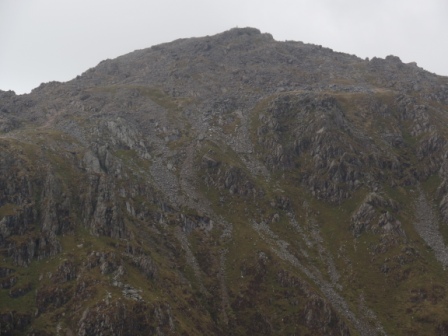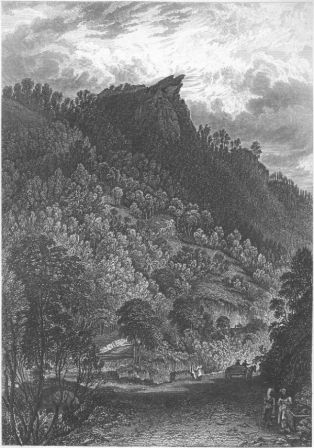Within Neo-Paganism Gwyn ap Nudd is generally understood to be a leader of ‘the Wild Hunt’. Before Jacob Grimm developed ‘the Wild Hunt’ as a concept applied to various otherworldly hunts across Europe in his Deutsch Mythologie (1835), they were known by individual names often referring to their leaders such as ‘Woden’s Hunt’, ‘Household of Harlequin’, and ‘Herla’s Assembly’. This essay will focus on the Brythonic tradition of ‘Gwyn’s Hunt’.
The earliest literary reference to Gwyn as a hunter comes from Culhwch and Olwen (1090) where it is stated, ‘Twrch Trwyth will not be hunted until Gwyn son of Nudd is found.’ This suggests Gwyn was the leader of the hunt for Twrch Trwyth, ‘King of Boars’, prior to Arthur. According to the text, which was penned by Christian scribes, Twrch Trwyth was a king changed into a swine by God ‘for his sins’. This overlay conceals a pagan tradition wherein the ‘boar’ was a human shapeshifter. Gwyn’s hunt was for a man: a shapeshifting human soul.
The following lines, ‘God has put the fury of the devils of Annwn in him, lest the world be destroyed. He will not be spared from there’ form another Christian overlay obscuring Gwyn’s role as a protector and ruler of Annwn containing furious spirits including the fay and the dead within his realm and person. The comb, razor, and shears Twrch Trwyth mysteriously carries between his ears may have been grave goods, suggesting he is a restless soul Gwyn hunts down into the ocean (symbolic of Annwn ‘the Deep’) on a cyclical basis to lay to rest.
In later folklore Gwyn is depicted hunting for souls with the Cwn Annwn, ‘Hounds of the Otherworld’, who are also known as Cwn Wybyr, ‘Hounds of the Sky’, and Cwn Cyrff, ‘Corpse Dogs’. These include Dormach, ‘Death’s Door’, Gwyn’s fair red-nosed hunting dog. To hear or see the Cwn Annwn is a portent of death. This belief may be rooted in earlier traditions where wolves and dogs along with carrion birds (Gwyn is also associated with ravens who ‘croak over blood’) devoured the corpses of the dead before Gwyn gathered their souls.
A fascinating legend surrounds the minstrel Ned Pugh or Iolo ap Huw who disappeared into the cave of Tag y Clegyr playing ‘Ffarwel Ned Pugh’, ‘Ned Pugh’s Farewell’:
‘To leave my dear girl, my country, and friends,
and roam o’er the ocean, where toil never ends;
to mount the high yards, when the whistle shall sound,
Amidst the wild winds as they bluster around!’
Exchanging ‘his fiddle for a bugle’ the minstrel became Gwyn’s huntsman-in-chief and can be found ‘cheering Cwn Annwn over Cader Idris’ every Nos Galan Gaeaf.

There are numerous instances where Gwyn (by this name or as a spectral or demon huntsman or fairy king), sometimes with his hunt and sometimes alone, also carries off the souls of the living. On Nos Galan Gaeaf, Gwyn wins back his beloved, Creiddylad, from Gwythyr and takes her to Annwn. Creiddylad’s descent with Gwyn to the underworld explains the coming of winter. Later tales of abduction may have some basis in this old seasonal myth.
Here, on the borders of Lancashire and Yorkshire, there is a story featuring Sybil, the Lady of Bearnshaw Tower, who spends an unseemly amount of time on the hills and moors chasing wild swans whose hound-like calls remind her of ‘wild hunters and the spectral horseman’. She is swept from the dizzy heights of Eagle Crag overlooking Cliviger Gorge by a ‘demon’:
‘Immediately she felt as though she were sweeping through the trackless air… she thought the whole world lay at her feet, and the kingdoms of the earth moved on like a mighty pageant. Then did the vision change. Objects began to waver and grow dim, as if passing through a mist; and she found herself again upon that lonely crag, and her conductor at her side.’
Gwyn ap Nudd, ‘White son of Mist’, goes ‘between sky and air’ and moves ar wybir ‘through the clouds’. I believe Gwyn is ‘the spectral horseman’ and Sybil’s demonic ‘conductor’.
Sybil’s ability to shapeshift may have been learnt from Gwyn: a god of transformation. In deer-form she is hunted down by a human huntsman called William Towneley and forced to marry him. Her failed attempt to escape in cat-form leads to her death and burial at Eagle’s Crag where she was captured; her ghost and William’s can be seen there every Nos Galan Gaeaf.

The Cliviger area is also haunted by Gabriel Ratchets, corpse hounds who may be an Anglicised variant of the Cwn Annwn. In his poem, ‘Gabriel Ratchets’, which is based on Sybil’s story, Philip Hamerton opens: ‘Wild huntsmen? ‘Twas a flight of swans / But how invisibly they flew.’
Gwyn and his hunt are associated with soul flight and ecstasis. Ecstatic experiences with otherworldly beings were frowned upon by the Christian church and twisted into stories of abduction by a demon huntsman or fairy king who was confronted by knights and heroes who won those ‘poor souls’ back (whether they wanted to return or not…).
When I accepted Gwyn’s challenge to ride with him to the Otherworld and offered my soul into his care he showed me parts of Lancashire where people lived in lake villages and walked on wooden trackways then glaciers creeping across the landscape with blizzard winds.
This has led me to believe Gwyn was worshiped as a god of hunting and the transitions of the souls of the dead and living between worlds by this land’s earliest inhabitants after the Ice Age. Yuri Leitch identifies Gwyn with the constellation of Orion and Dormach with Canis Major (Sirius, the dog star is Dormach’s red nose). Gwyn is our ancient British Hunter in the Skies who rises from Annwn on Nos Galan Gaeaf and presides over the dark months of winter.
Nos Galan Gaeaf is an ysbrydnos ‘spirit night’ when Gwyn’s Hunt rides and the borders between thisworld and Annwn, life and death, and the laws that govern time and space break down. It is a time of migrating swans and geese and transitions of souls. It is a time of deep magic.
I’ll end with a passage from Sian Hayton’s ‘The Story of Kigva’ because it evokes for me so beautifully the experience of flying with Gwyn:
‘She felt a hand on her arm… steady, comforting her in her despair. The strongest one of all was there, as he had been in the forest and he promised, silently, that he would stay with her for the rest of her vigil. With tears she thanked him and felt herself gathered up in his arms. Together, from then on, they wandered the universe. He showed her things which only he knew. With him she touched the cold, hard moon and walked on the black rind of the sky. She found the stars felt like the taste of blaeberries and the north wind was truly a great river whose source was the mountains of the sun. He gave her jewelled collars and crowns and broke open an oak-tree so that she could feast on the honey. There was no one equal to him.’
Reblogged this on Signposts in the Mist and commented:
For Nos Galan Gaeaf: An article on soul hunting and soul flight in the Brythonic tradition of Gwyn’s Hunt on this night of deep magic as the borders between thisworld and Annwn, life and death, and the laws that govern time and space break down.
LikeLiked by 2 people
Wow, I wish I had come across that extra element of the story of Lady Sibyl before I wrote it down for my article on folklore! The version I heard involves another shape-shifting woman who, in the guise of a white hound with red ears, leads Sir William’s dogs in the hunt for Lady Sibyl – a retelling which is no doubt inspired by the description of the hounds of Annwn.
There is so much to unpick in this rich evocation of the myths of this time. The Twrch Trwyth as the shapeshifting soul of a man recalls Lleu Llaw Gyffes, discovered after ‘death’ when Gwydion follows the great white sow to the oak where his dead flesh falls from his transformed body.
Kigva, similarly, has a name which etymologically suggests flesh. There is something going on with the swine in Brythonic mythology, something deeply symbolic of the experience of incarnated existence…
LikeLiked by 1 person
I had to leave out Mause Helton’s role for the sake of brevity. I often wondered what her motivation was in giving William the noose and helping hunt Sybil down considering their likenesses as ‘witches’/wild women connected with the ‘spectral huntsman’. My guess is that there might have been some kind of rivalry between them? I have read a variant where Mause-as-hound is ‘white with chesnut-brown ears’ – very Cwn Annwn!
LikeLiked by 2 people
What ?
LikeLike
An inspirational weaving of stories around this theme creating a rich tapestry for the season.
I think this tying together of different Brythonic survivals in traditional lore is invaluable to our project of re-discovering and re-imagining our Brythonic heritage.
LikeLiked by 1 person
The white hounds with red ears refer to canis major and canis minor in the sky! The great hunter is Orion( very similar in sound to Arawn (a-ra-wn). Great info at
http://mabinogionastronomy.blogspot.co.uk/2014/07/pryderi-pwyll-and-arawn.html?m=1
LikeLiked by 1 person
These attempts as connecting myths to astronomy are always so tenuous. There isn’t much at all to suggest that the ancient British saw that constellation as a dog. The origins of the names Orion and Arawn are VERY different. they are not connected.
LikeLiked by 1 person
The comb, razor, and shears Twrch Trwyth mysteriously carries between his ears is explained as the story originally coming from astronomy, all in the sky!
Explained brilliantly here..
http://mabinogionastronomy.blogspot.co.uk/2013/07/?m=1
“So it is easy to see how the Claws can become scissors, it’s such a natural analogy, likewise the Scorpion’s many legs between the two ears of the Beast may instantly be understood as a comb, and the sting in the tail of the Scorpion as a visual metaphor for the razor is matched in the shape of the tusk of Yskythrwyn Penbaedd, the razor originally demanded by Yspyddaden Pencawr for his ‘shave’. In other words these are clever and humourous visual puns, naturally arrived at; but it is a thin disguise, designed to reveal, ultimately, the author’s barely concealed agenda.”
LikeLiked by 1 person
IIRC, Culhwch ac Olwen predates the supernova by a century or so. As there is no mention of the sky…why is this so vague and tenuous. Why is there simply no mention of it needing to be pulled from the sky?
LikeLiked by 1 person